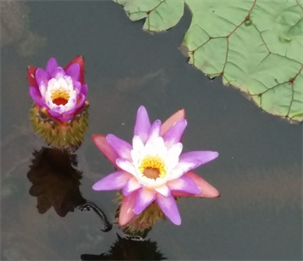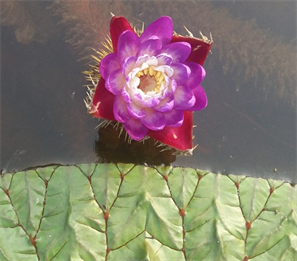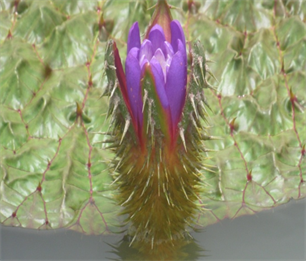1. Introduction
Gorgon nut, Euryale ferox (Salisb) or makhana is one of the most important aquatic medicinal plants native to south east or eastern Asia, particularly India and China. However, wild forms of plants in wetland ecosystem were also found in Korea and Japan, as well as parts of eastern Russia [1] . During spring, it grows in water and produces bright purple flowers during May. It is a photo insensitive crop and can be grown successfully from March to September in economic way in India. Floating leaves are prickly on petioles and along veins and the underside of the leaf is purplish, while the upper surface is green. All the plant parts are thorny outside. It thrives best in ponds, wetlands, lakes and lowland in tropical and subtropical regions of India. Field cultivation of Euryale is also recommended where plenty of water is available. Euryale is famous for its [2] high valued seeds marketed in India, China, and Japan [3] . In India particularly in Bihar, more than 96,000 hectares were under cultivation in 1990-1991 [2] . But in present condition it is cultivated about 11,000 ha only [4] . According to [5] it is now becoming under extinction due to rapid urbanization and profitable fish production in wetland area instead of Euryale, which is labor intensive. In Mithila culture of Darbhanga, Euryale or makhana is known for its auspicious ingredient used in offerings to the Goddesses during “Durga Puja” festivals. Evidence from archaeobotany indicated that Euryale was a frequently collected as wild food source during the Neolithic period in the Yangtze region [6] . The earliest record showed that use of Euryale ferox to date was found in Gesher Benot Ya’aqov, Israel, among artifacts of the Acheulean culture 790 - 750,000 years ago [7] . Edible seeds of Euryale are used in traditional Chinese medicine, where they are often cooked in soups along with other ingredients [8] . Though it is an eastern and south Asian species, it is widespread and recorded from the Russian Federation, India (Assam, Bihar, Jammu and Kashmir, Manipur, Meghalaya, West Bengal), Japan (Honshu, Kyushu), Republic of Korea, Taiwan (Province of China), Bangladesh and Myanmar [9] [10] . This plant has edible and medicinal uses. Makhana kernel powder is said to have control of cardiovascular diseases [11] . It is taken internally in the treatment of chronic diarrhoea, vaginal discharge and kidney weakness [12] [13] . The genera Euryale of east Asia, and Victoria from far South America, are closely related despite their geographic distance [14] [15] [16] . Flower is epigynous with more than 40 corolla [17] , ovary 7 - 16 chambered with 6 - 8 seeds/locule [5] .
The objectives of this study were to understand about the flower structure, pollination time and per cent pollination of Euryale in relation to weather. Different type of pollinations and the development of hybridization techniques in Euryale under field condition were other important objectives in this present study to initiate future breeding program of this crop in India.
2. Materials and Methods
The experiment was carried out at ICAR-RCER, Research Centre for Makhana, Darbhanga, Bihar, India, during 2017. Makhana was cultivated from April onwards to October. Flowering period covered from Mid May to November. In our germplasm block, 28 germplasm of different morphological structures collected from different parts of India were the basic materials for study. We have selected 10 outstanding selections with differences in floral structures and pollination behaviors were studied. The floral characters like number of calyx, number of corolla, androecia, sessile ovary with different stigmatic color and ovaries with different chambers and their ovules were studied thoroughly. Complete Randomized Design (CRD) was followed to analyze the data statistically for flower characters. Fisher protected LSD (P > 0.05) was adapted to analyze the data on pollination % and duration of pollination and seed formation (number) in different types of pollination. Plant yield performance and yield correlation with flower morphological characters were delineated statistically by using Karl Pearson Correlation coefficient. Stigmatic color was recorded by UPOV color chart [18] . Favorite pollination periods with temperature range were recorded for better flowering and fruiting. To study the chasmogamy, air opened flowers before dehiscence of anthers were tagged from July to Nov and number of flowers to total numbers of flowers also calculated including their seed. Pollination % and different flower percent was calculated by the following sequence:
To obtained hybrid seeds from hybridization, a few precautions were taken as it was wetland aquatic crop and after artificial hybridization, hybrid fruit generally submerged again to mature the seeds after 7 - 10 days of pollination. Emasculation and hybridization were performed safely. Water level was maintained 10 - 15 cm during hybridization period so that pollinated flowers did not damage.
3. Results and Discussion
A close perusal of the Table 1 revealed that the number of flower/plant varies from 8.33 (Manipur-9) to 16.33 (Superior Selection-1). These results were in conformity of the study conducted by [19] . The maximum floral parts were also observed in Superior Selection-1 (calyx + corolla + androecia = 4 + 42 + 127). The minimum floral parts were found in Selection 17 (calyx + corolla + androecia = 4 + 22 + 68). There were positive correlations with different floral parts to yield. On the contrary, Manipur-2 also produced little flower but its yield capacity was higher due to production of increased number of flower/plant. Flower size ranged from 23.16 cm2 in Selection 17 to 33.79 cm2 in Superior Selection-1. Flower stalk length varies significantly among the germplasm whereas as flower stalk girth did not. Zhuang [5] also reported that a flower of Euryale was about
![]()
Table 1. Physical characteristics of flowers of Euryale in wetland ecosystem in north Bihar-2017.
5.0 cm diameter and outer skins of the flowers are densely pricked. Data pertaining to Table 2 enable us to explain that the highest innerovary area was noticed in Superior Selection-1 (6.62 cm2) followed by Swarna Vaidehi (6.24 cm2). The germplasm Selection-17 had less number of colored corollas (Violet-10) whereas Superior Selection-1 had the maximum (Pink-22). According to [17] , the total corolla was greater than 40, which was further confirmed by [7] . In the present study, we found that minimum locule 11 and embryos 4.8 which were found in Selection 17 whereas Superior Selection-1 had the maximum locule of 17 with 8 embryos/locule. [17] stated that multicarpellary, syncarpous inferior ovary which had 7 - 12 locules were present in Euryale. According to [5] , in Euryale ovary was 7 - 16-loculed, each locule with 6 - 8 or more ovules. Flowers of Euryale were epigynous, petals outer purple, violet or pink fading to inner white and gradually smaller (oblong-lanceolate) and tapering large calyx kept the flower air tight in water. This result about flower structure was confirmed by [20] [21] [22] . After transplanting flowering needs and 45 days and flowering periods last for 40 days and peak flowering was observed between 60 - 70 days (Figure 1 and Plates 1-4).
Arrangement of calyx and corolla was so nicely designed it paves the way to CL, assured self pollination before opening of the flower and in Euryale self pollination happened when flowers remain closed and with in water. By destructive method, we found that flower bud emerging out of the bract and after 3 - 4 days, self pollinated, i.e. CL occurred. CH i.e. self pollination in open flowers happened after July onwards when the water level of the field drastically reduced and in terminal 4th-5th flowers CH occurred. The terminal 1-3rd flowers were
![]()
Table 2. Dissected flowers of Euryale and their characters under wetland ecosystem of north Bihar-2017.
![]()
Figure 1. Pollination periods and number of flowers in some Euryale germplasm [CRD with 3 replications].
small and desiccated in air during pollination or hybridization periods. CHS flower increased up to 22.5% in October (Figure 2). For artificial cross pollination, terminal 4-5th were the vital flowers opened in air so emasculation and hybridization become feasible. Due to last season of growth, terminal last 2 flowers
![]()
Figure 2. Percentage of different types of pollinated flowers of Euryale [Fisher protected LSD (P ≤ 0.05)].

Plate 1. Manipur-2.

Plate 2. Selection-17.

Plate 3. Superior Selection-1.

Plate 4. Swarna Vaidehi.
get dried due to water stress. Although CH was happened in last 4-5th flower, the seed production was less. Number of seed ranged from 11.25/fruit in July to 28.33/fruit in September (Figure 3). The Japanese scientist Kadono [23] also reported that CH was gradually increased after July onwards in Euryale plant.
In our seasonal study, we grown Euryale from January to December and it was found that July transplanted and August transplanted gorgon nut thrives well under autumn atmosphere of India. Their flowering period was in August and September of the same season and gave highest plant growth and yield. It has been found that yield and growth and weather were correlated. The temperature 29˚C - 31˚C and humidity 79% - 81% were ideal for Euryale cultivation (Figure 4). This result was corroborated by Mandal et al. [24] . During October 80.00 per cent pollination was observed. Color of the stigma varied from Light Yellow (004D) in Manipur-9, Manipur 23 and Superior Selection-1 to Orange Red (032A) in Manipur-2 germplasm while pollen was very minute and white in all
![]()
Figure 3. Seed formation of different types of pollinated flowers of Euryale [Fisher protected LSD (P ≤ 0.05)].
![]()
Figure 4. Euryale flowers and pollination in relation to a particular weather [CRD with 3 replications for characters pollination % and duration of pollination].
Euryale germplasm.
All floral characters were correlated with yield, which is calculated from number of fruit, number of seed and average weight of seed. It has been found that besides flower stalk, girth of stalk and number of calyx, all the quantitative characters were highly correlated with yield. There was a strong correlation between number of embryos (r = 0.762) and ovary area (longitudinal) (r = 0.681) with yield (Figure 5). According to [25] among 14 traits studied, 100-seed weight was observed to have highest contribution (57.30%) towards genetic divergence followed by seeds/fruit (18.25%) and fruit diameter (17.46%). Stigma was sessile and stigmatic color varied from light yellow (004D) to orange red (032A). The flowers having deeply colored stigma produced less yield as compared to light colored once.
4. Conclusion
From the present study, we concluded that CLS flowers are appropriate for commercial cultivation. Hybridization can be possible through CHS flower as these flowers are produced at later stage of plant growth and development and opened in air before dehiscence of anther. These flowers are small in size and
![]()
Figure 5. Correlation of different floral characters with yield of Euryale. [Karl Pearson correlation, *Significant r = 3.61].
produce less seeds in their fruits. For hybridization program water label of the field must be maintained 10 - 15 cm. After hybridization flowers were tagged and kept in air for 7 - 10 days for healing after emasculation injury. After that again water level was increased to submerge the fruits to get mature hybrid seeds. Flowers having a greater number of floral parts i.e. calyx, corolla and androecia produced the higher yield. The flower size and inner ovary area had the positive correlation to yield.
Acknowledgements
Author is thankful to Director, ICAR-RCER, Patna, India to muster up the information related to flower characters, pollination and possible hybridization in aquatic growing condition of Euryale ferox for further crop improvement program.
Jana, B.R. (2018) Flower Characteristics and Pollination Behavior of Euryale ferox (Salisb.). American Journal of Plant Sciences, 9, 722-731. https://doi.org/10.4236/ajps.2018.94057
References
- 1. Cronquist, A. (1981) An Integrated System of Classification of Flowering Plants. Columbia University Press, New York, 111.
- 2. Processed Products: Makhana Phool (2010). http://www.miltopexports.com/makhana_phool.htm
- 3. Mabberley, D.J. (1987) The Plant-Book. Cambridge University Press, Cambridge.
- 4. JIT Report (2014) Mission for Integrated Development of Horticulture in Bihar, 31st May to 4th June, 2014. Ministry of Agriculture, Department of Agriculture & Cooperation Krishi Bhawan, New Delhi, 7.
- 5. Zhuang, X. (2011) Euryale ferox. The IUCN Red List of Threatened Species. Version 2014.3. http://www.iucnredlist.org/details/168756/0
- 6. Fuller, D.Q., Qin, L., Zheng, Y., Zhao, Z., Chen, X., Hosoya, LA., et al. (2009) The Domestication Process and Domestication Rate in Rice: Spikelet Bases from the Lower Yangtze. Science, 323, 1607-1610. https://doi.org/10.1126/science.1166605
- 7. Goren-Inbarand, N., Melamed, Y., Zohar, I., Akhilesh, K. and Pappu, S. (2014) Beneath Still Waters—Multistage Aquatic Exploitation of Euryale ferox (Salisb.) during the Acheulian. Internet Archaeology, 37.
- 8. IUCN (2011) IUCN Red List of Threatened Species (Ver. 2011.2).http://www.iucnredlist.org/
- 9. Wu, Z.Y., Raven, P.H. and Hong, D.Y., Eds. (2003) Flora of China. Science Press and Missouri Botanical Garden Press, Beijing and St. Louis.
- 10. USDA, ARS, National Genetic Resources Program (2010) Germplasm Resources Information Network—(GRIN) [Online Database]. Beltsville, Maryland. http://www.iucnredlist.org/details/biblio/168756/0
- 11. Das, S., Der, P., Roychoudhury, U., Maulik, N. and Das, D.K. (2006) The Effect of Euryale ferox (Makhana), an Herb of Aquatic Origin, on Myocardial Ischemic Reperfusion Injury. Molecular and Cellular Biochemistry, 289, 55-63. https://doi.org/10.1007/s11010-006-9147-1
- 12. Li, M.H., Yang, X.Q., Wan, Z.J., Yang, Y.B., Li, F. and Ding, Z.-T. (2007) Chemical Constituents of the Seeds of Euryale ferox. Chinese Journal of Natural Medicines, 5, 24-26.
- 13. Duke, J.A. (2010) Phytochemical and Ethnobotanical Databases. http://www.iucnredlist.org/details/biblio/168756/0
- 14. Löhne, C., Borsch, T. and Wiersema, J.H. (2007) Phylogenetic Analysis of Nymphaeales Using Fast-Evolving and Noncoding Chloroplast Markers. Botanical Journal of the Linnean Society, 154, 141-163. https://doi.org/10.1111/j.1095-8339.2007.00659.x
- 15. Borsch, T., Löhne, C. and Wiersema, J. (2008) Phylogeny and Evolutionary Patterns in Nymphaeales: Integrating Genes, Genomes and Morphology. Taxon, 57, 1052-1081.
- 16. Dkhar, J., Kumaria, S., Rama Rao, S. and Tandon, P. (2012) Sequence Characteristics and Phylogenetic Implications of the nrDNA Internal Transcribed Spacers (ITS) in the Genus Nymphaea with Focus on Some Indian Representatives. Plant Systematics and Evolution, 298, 93-108. https://doi.org/10.1007/s00606-011-0526-z
- 17. Kumar, L., Gupta, V.K., Jha, B.K., Singh, I.S., Bhatt, B.P. and Singh, A.K. (2011) Status of Makhana (Euryale ferox Salisb.) Cultivation in India-Tech Bull. No. R-32/PAT-21 ICAR-RCER Patna, 31.
- 18. UPOV (2006) Color Names of RHS Colour Chart: International Union for the Production of New Varieties of Plants. UPOV, Geneva.
- 19. Kumari, A., Singh, I.S., Lokendra, K., Amit, K., Ramesh, K. and Gupta, V.K. (2014) Morphological Characteristics of Makhana Germplasm of Manipur and Darbhanga Conditions. Journal of AgriSearch, 1, 157-170.
- 20. Houtte, L. (1853) Flore des serres et des jardin de l’Europe. Vol. 8, 82.
- 21. Okada, Y. (1930) Study of Euryale ferox Salisb. VI. Cleistogamous versus Chasmogamous Flower. The Botanical Magazine, Tokyo, 44, 369-373. https://doi.org/10.15281/jplantres1887.44.369
- 22. Moseley, M.F. and Williamson, P.S. (1984) The Vasculature of the Flower of Euryale ferox. American Journal of Botany, 71, 40-41.
- 23. Kadono, Y. and Schneider, E.L. (1987) The Life History of Euryale ferox Salisb. In Southwestern Japan with Special Reference to Reproductive Ecology. Plant Species Biology, 2, 109-115. https://doi.org/10.1111/j.1442-1984.1987.tb00037.x
- 24. Mandal, R.N., Saha, G.S. and Sarangi, N. (2010) Harvesting and Processing of Makhana (Euryale ferox Salisb.)—A Unique Assemblage of Traditional Knowledge. Indian Journal of Traditional Knowledge, 9, 684-688.
- 25. Kumar, L., Choudhary, A.K., Bhatt, B.P. and Singh, K.P. (2015) Genetic Divergence in Makhana (Euryale ferox Salisb.). Indian Journal of Horticulture, 72, 365-369.